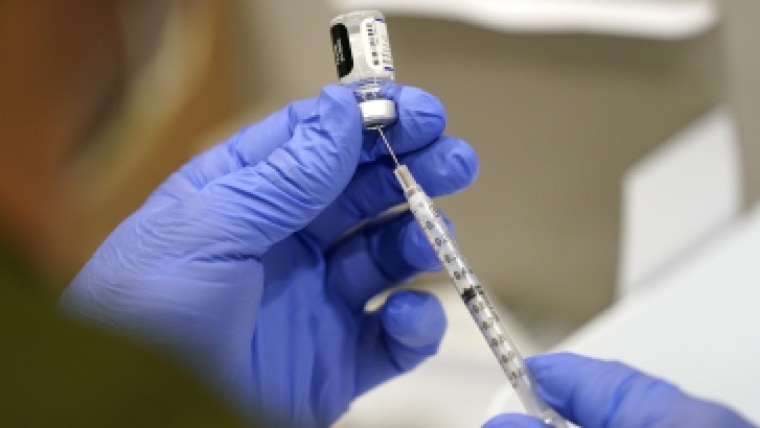Free Covid tests are back to remind us what good governance looks like
Ahead of what’s shaping up to be another seasonal spike in Covid-19 cases, the Biden administration is once again offering free at-home tests through the U.S. Postal Service. Starting Monday, anyone who wants four tests shipped to their home simply has to go to CovidTests.gov and fill out a short form. It’s quick, efficient and has the potential to save lives. At the same time, it’s a reminder of how low we’ve set the bar when it comes to our expectations — of government services broadly and of public health in particular.
When President Joe Biden took office with a Democratic majority in both houses of Congress, it seemed like a real opportunity to showcase how much good government can do for people. A massive stimulus bill leveraged the pandemic’s immediate needs into an expansion of the social safety net that kept millions from falling into poverty. The initial Build Back Better plan that Biden pitched was packed with investments that would let those expansions take root and shift society in a way that we haven’t seen in decades.
When President Joe Biden took office with a Democratic majority in both houses of Congress, it seemed like a real opportunity to showcase how much good government can do for people.
Slowly but surely, though, those dreams were pared down. Bits and pieces of the initial $4 trillion plan were hacked away, either spun out into separate bills to win congressional votes or allowed to wither to lower the overall price tag. The intransigent wall of Republican opposition to what was left was aided in the Senate by two holdouts, one of whom is plotting a re-election bid that relies more on Republican votes than Democratic. The final set of bills that did pass, while impressive in their own right, pale in comparison to what could have been.
It would be one thing if the downscaling of those services was based on the failure of the pandemic’s pilot programs. But that’s certainly not the case. The Child Tax Credit expansion was allowed to expire — despite the child poverty rate falling to record lows. There’s no evidence that workers were abusing the expanded paid sick and family leave — but those provisions, too, have been mostly allowed to expire with the end of the Covid-19 emergency declaration.
As a result, we’ve seen a related contraction in public health services on offer. Private health insurance companies are no longer required to cover the cost of laboratory Covid testing. The newly released updated Covid vaccine is the first that the federal government won’t cover the full cost of. Instead, what you pay will depend on your type of insurance and whether you get the shot from an in-network provider — a new system that’s already led to headaches nationwide. (The government is providing free vaccines to uninsured people for now — but the program is only scheduled to last until December 2024.)
Which brings us back to the free at-home testing kits that are once again available. There was no guarantee that the program would restart after the most recent round of tests went out last fall. And the end of the emergency declaration means that private insurance companies are no longer required to cover eight at-home tests per month. That makes the program especially welcome — particularly since it has been paused in the past for being too popular — to keep up with the government’s stockpile of tests.
Even a flawed at-home testing program shows that the federal government can still do things that help people and can do them efficiently.
That’s not to say that it’s a perfect program, either in practice or in philosophy. It requires people to opt-in, rather than automatically providing tests to everyone. It also is limited to four per household, a monthly allotment that is half as many as were covered until recently. I understand the impulse to conserve tests, instead of potentially wasting them by sending them to people who (for whatever reason) simply won’t use them. But that waste doesn’t necessarily outweigh the benefit of having tests available in as many households as possible, given they’re most useful when people are at their most infectious.
I last caught Covid in August and had one test left from last year — but the testing solution refused to fall onto the testing strip. It bubbled out from the dropper and didn’t even deposit enough to give a result one way or the other. Layered onto how terrible I felt physically, I also had to deal with the guilt I felt at potentially exposing others when I went to the pharmacy to buy a set of fresh tests. If the goal is to keep the greatest number of people safe and healthy, each additional constraint or roadblock to adequate testing is another potential infected person who passes on the virus.
Broadly speaking, even a flawed at-home testing program shows that the federal government can still do things that help people and can do them efficiently. There’s a reason that while Americans’ public trust in the federal government is currently near a historic low, it ticked up in 2020 and 2021, exactly when the usual fetters were removed and people got the help that they actually needed. This program should be a model for future initiatives, to recapture that energy and have a real impact on people’s lives; it need not serve merely as a reminder of how things could have been.
No Byline Policy
Editorial Guidelines
Corrections Policy
Source
